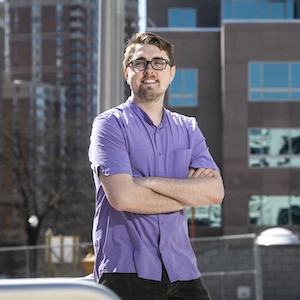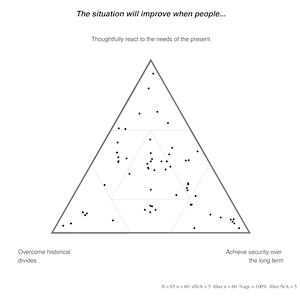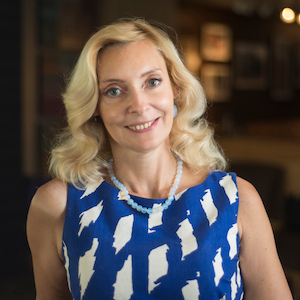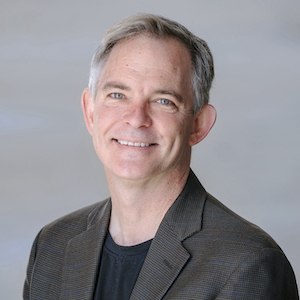In This Story
Despite being more than 5,000 miles away from the war in Ukraine, students at George Mason University’s Carter School for Peace and Conflict Resolution are actively assessing the conflict dynamics, with hopes that their research could improve the situation.

“A lot of students in [Solon Simmons’ Peace Engineering and Participatory Approaches to Narrative] class felt it would be important to do what we could locally with our set of methods and tools to try and help,” said Keil Eggers, Peace Engineering Lab manager and Carter School PhD student.
They’re creating a digital map of the war through peoples’ lived experiences.
Mapping the Conflict
The team, which includes faculty and seven students ranging from the undergraduate to PhD levels, is creating this map using SenseMaker, a program that allows for a large-scale collection of narratives.
Their SenseMaking in Ukraine project asks participants—ranging from U.S. citizens to those impacted on the ground in Ukraine and Russia—to answer one of three prompts. Responses can be submitted in English, Ukrainian or Russian:
- How can ordinary people support peace in Ukraine? Share one of your lived experiences that shows how help can be given or how it has been blocked.
- Start a conversation: Tell us one of your lived experiences that you would want people who are on the other side to hear.
- What have you noticed about the conflict in Ukraine that makes you hopeful or concerned about a peaceful future
A unique aspect of SenseMaker is that participants evaluate their submissions through questions, including a series of triangles, where each point represents an opinion.

For the question, “The situation will improve when people…,” the points represent:
- Thoughtfully react to the needs of the present
- Overcome historical divides
- Achieve security over the long term
“By placing their dot as a balance between one of those factors, you get quantitative data for each person’s story,” Eggers said, adding that Mason students designed the survey questions and will support the data analysis.
The data will help uncover patterns, he said, and will become part of a public dashboard the team is creating to support understanding and next steps.
Impacting Change
This is the first time the school has used SenseMaker in an active conflict, Eggers said. The class hopes to influence change by hosting workshops about the narratives.
“You get people directly thinking about what they can do in their own lives, whether that’s giving aid, doing some kind of really local small action, or for somebody who’s actually making decisions, to change policy.”
More Than a Story
“The SenseMaking tool is one way to uncover the very complex process of meaning-making in how people see the peace process,” said Karina Korostelina, professor and director of the Program for the Prevention of Mass Violence.

In Ukraine, she said, peacemaking will likely include territorial concessions, which create moral dilemmas. Another dynamic, she said, is that people on both sides view the conflict drastically differently because of Putin’s information war.
“Helping reveal these complex patterns, and how people think about the issues, is very important for informing the peace process because governments and international actors have to know how people see and think about it,” she said.
The class, which is part of the school’s Peace Engineering Lab, exemplifies the Carter School’s key principles of innovation, integration of research and practice, and global impact, said Dean Alpaslan Özerdem.

Students also benefit from the experience, as their contributions have peace-impacting potential.
“SenseMaking in Ukraine brings an innovative way of responding to the war, and preparing our future capacities and knowledge base for the war’s end, so that the Carter School could respond to its peacemaking and peacebuilding challenges from a more informed basis with solid partnerships on the ground,” Özerdem said. “It shows the real impact that our Peace Labs have started to have.”
